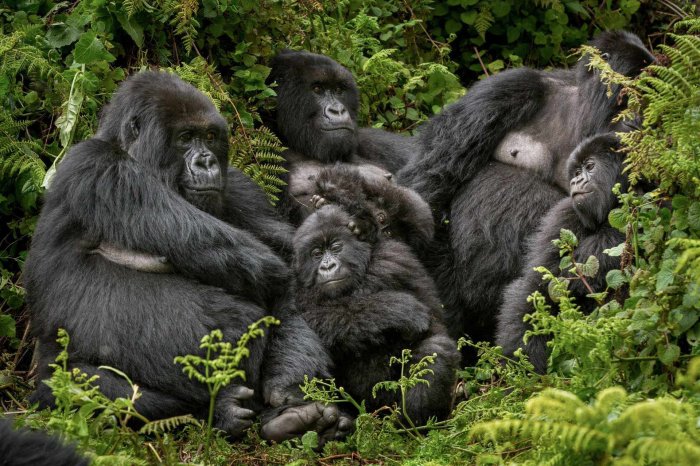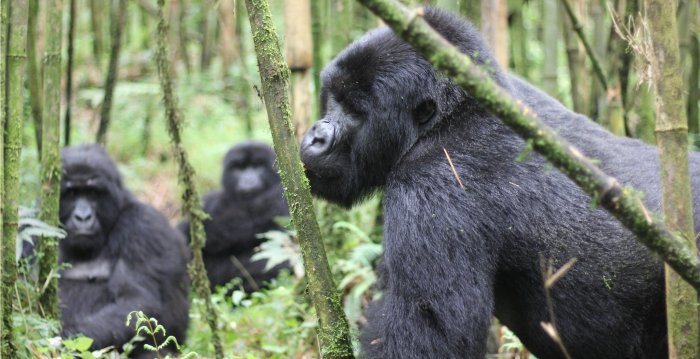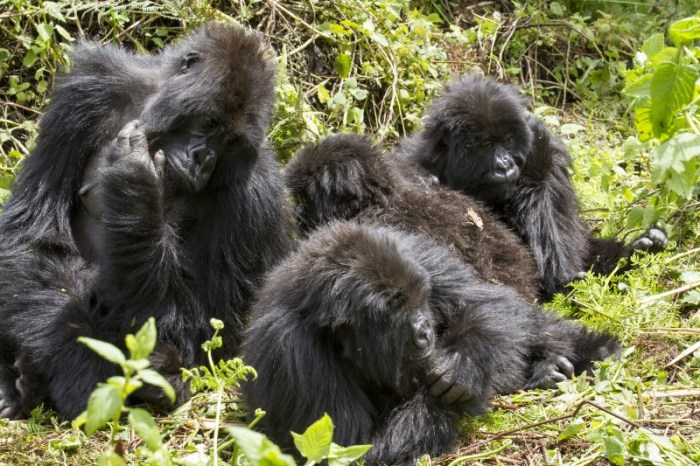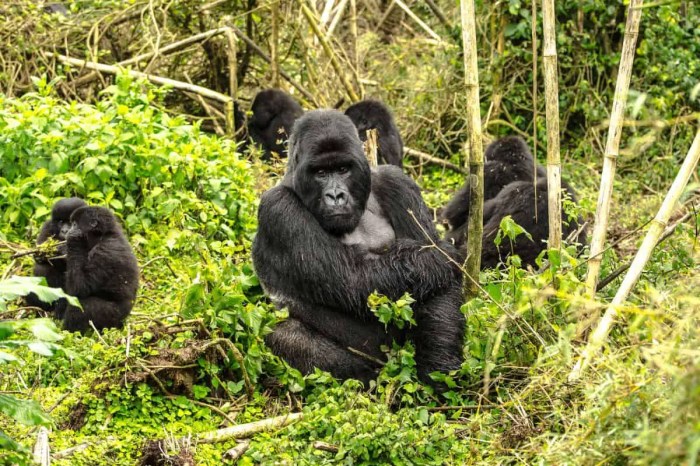A group of gorillas is called a troop, and these magnificent creatures live in complex social structures that shape their behavior, communication, and survival. Delve into the fascinating world of gorillas and discover the intricacies of their troop dynamics, from family bonds to bachelor groups and solitary individuals.
Gorillas are highly social animals, and their troops provide a sense of belonging, protection, and support. Within each troop, there is a clear hierarchy, with a dominant silverback male leading the group and maintaining order. The troop’s composition can vary depending on factors such as habitat, food availability, and social dynamics.
Collective Nouns for Gorillas

A collective noun is a noun that refers to a group of people, animals, or things. Collective nouns are used to make it easier to talk about groups of individuals as a single unit. The collective noun for a group of gorillas is a “band”.
Origins and Evolution
The collective noun “band” is thought to have originated from the way that gorillas live in social groups. Gorillas live in groups of up to 30 individuals, with one dominant male leading the group. The dominant male is responsible for protecting the group from predators and other threats.
The other members of the group, including females and young gorillas, rely on the dominant male for protection and leadership.
The term “band” is used to describe a group of gorillas because it reflects the social structure of the group. Gorillas live in close-knit groups, and they rely on each other for survival. The dominant male is the leader of the group, and he is responsible for keeping the group together and safe.
Types of Gorilla Groups: A Group Of Gorillas Is Called A

Gorillas live in various group structures, each with distinct social dynamics and hierarchies. These groups primarily consist of family groups, bachelor groups, and solitary individuals.
Family Groupsare the most common type of gorilla group, comprising a dominant silverback male, several adult females, and their offspring. The silverback leads and protects the group, while the females form strong bonds and care for the young. Within the family, a strict hierarchy exists, with the silverback holding the highest rank, followed by the adult females and then the younger gorillas.
Bachelor Groups
Bachelor groups consist of young adult males who have left their natal family groups. These groups are typically smaller and less stable than family groups, as males compete for dominance and mating opportunities. However, they may also engage in cooperative behaviors, such as foraging and defense against predators.
Fun fact: a group of gorillas is called a troop! Did you know there’s also a drinking goblet word ladder ? Word ladders are a fun way to learn new words and expand your vocabulary. And hey, back to gorillas, a troop of them can be quite a sight to behold!
Solitary Individuals
Solitary gorillas are typically older males who have been displaced from their family groups. They live alone and have limited social interactions with other gorillas. Solitary individuals may be more vulnerable to predators and other threats due to their lack of group protection.
The social dynamics and interactions between gorilla groups vary depending on the group type and individual personalities. Family groups typically maintain close bonds and communicate through vocalizations, gestures, and physical contact. Bachelor groups may engage in more competitive and aggressive behaviors, while solitary individuals are more independent and have less frequent interactions.
Communication and Language

Gorillas communicate using a diverse range of vocalizations, gestures, and body language. Their vocal repertoire includes various grunts, barks, screams, and hoots, each with specific meanings and contexts. For instance, a soft grunt may indicate contentment, while a loud bark can signal alarm or aggression.
Vocalizations, A group of gorillas is called a
Gorillas possess a complex vocal system that allows them to convey a wide range of messages. They produce a variety of grunts, screams, and hoots, each with distinct meanings. Researchers have identified over 25 different vocalizations, including:
- Grunts:Low-pitched sounds used for general communication, such as reassurance or contentment.
- Barks:Short, sharp sounds that indicate alarm or aggression.
- Screams:High-pitched vocalizations that express fear or pain.
- Hoots:Long, resonant sounds that are often used to attract attention or maintain contact.
Gestures and Body Language
In addition to vocalizations, gorillas communicate through gestures and body language. They use facial expressions, such as lip smacking and teeth baring, to convey emotions and intentions. They also employ a variety of hand gestures, including clapping, slapping, and pointing, to communicate with each other.
Potential for Language-like Abilities
Some researchers believe that gorillas have the potential to develop language-like abilities. They have observed gorillas using gestures and vocalizations in a way that suggests they may be able to understand and produce simple sentences. However, further research is needed to determine the full extent of their linguistic capabilities.
Habitat and Distribution

Gorillas, the largest living primates, are native to the forests and mountains of central and western Africa. Their geographical distribution is limited to a narrow belt stretching from the Atlantic coast of Nigeria in the west to the eastern Democratic Republic of Congo (DRC).
This region encompasses a diverse range of habitats, including tropical rainforests, montane forests, and swamps.
Habitat Preferences
Gorillas are primarily forest-dwelling animals, preferring dense vegetation that provides ample food, shelter, and protection from predators. They are highly adaptable, however, and can be found in a variety of forest types, from lowland rainforests to high-altitude montane forests. Gorillas have also been known to venture into swamps and grasslands in search of food or new territory.
Environmental Factors
The distribution and abundance of gorillas are influenced by several environmental factors, including:
-
-*Habitat loss
Deforestation, primarily for agriculture and logging, is the most significant threat to gorillas. Loss of habitat fragments populations, reduces food availability, and increases the risk of human-wildlife conflict.
-*Climate change
Changes in temperature and precipitation patterns can alter the availability of food and water resources for gorillas, potentially affecting their survival and reproduction.
-*Disease
Gorillas are susceptible to a variety of diseases, including respiratory infections, gastrointestinal diseases, and parasites. Disease outbreaks can decimate gorilla populations, especially in areas where human encroachment and habitat loss have weakened their immune systems.
Conservation and Threats

Gorillas face numerous threats to their survival, including habitat loss, poaching, and disease. Habitat loss is a major problem, as gorillas rely on large areas of forest to survive. Deforestation for agriculture, logging, and mining is destroying gorilla habitats at an alarming rate.
Poaching is another serious threat, as gorillas are hunted for their meat and fur. Disease can also devastate gorilla populations, particularly respiratory infections and Ebola virus.Conservation efforts are underway to protect gorillas and their habitats. These efforts include establishing protected areas, such as national parks and wildlife sanctuaries, to provide safe havens for gorillas.
Conservationists are also working to educate local communities about the importance of gorillas and to promote sustainable practices that protect gorilla habitats.The challenges of gorilla conservation are significant. Habitat loss and poaching continue to threaten gorilla populations, and disease outbreaks can be devastating.
However, conservation efforts are making a difference. Protected areas are helping to safeguard gorilla habitats, and education and awareness campaigns are changing attitudes towards gorillas.The successes of gorilla conservation are encouraging. Gorilla populations are slowly recovering in some areas, and conservation efforts are helping to raise awareness about the importance of these animals.
However, much more work is needed to ensure the long-term survival of gorillas.
Query Resolution
How many gorillas are typically in a troop?
Troop sizes can vary, but typically range from 5 to 30 individuals.
What is the role of the silverback male in a troop?
The silverback male is the dominant leader responsible for protecting the troop, resolving conflicts, and maintaining social order.
Do gorillas communicate with each other?
Yes, gorillas use a variety of vocalizations, gestures, and body language to communicate with each other.
